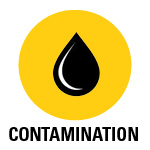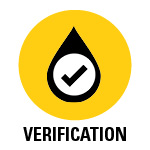Oil Analysis
Lubrication oil performs several basic functions in order to provide adequate lubrication. It works to keep compartments clean and free from rust and corrosion. It acts as a coolant and sealant; and it provides an oil film cushion that keeps metal to metal contact to a minimum, thereby reducing friction and wear.
Proper oil maintenance is imperative to keep equipment operating at peak performance. Oil maintenance includes scheduled oil changes and oil analysis. Oil Analysis is important because the performance of oil slowly degrades with time. This degradation takes place and the amounts of wear metals and contaminants increase.
Under severe operating conditions, the degradation process can be accelerated. In either normal or severe conditions, oils eventually lose the ability to adequately lubricate and protect parts from accelerated wear and damage.
Our Oil Analysis Program uses a wide range of tests to determine the condition of the oil and the condition of the lubricated compartment. The testing process is designed around four types of analyses for lubricants. We evaluate the sample for Component Wear, Oil Condition, Oil Contamination and Oil Verification.
A regular schedule of oil sampling:
- Detects early signs of abnormal wear on internal components.
- Monitors oil degradation and its ability to do its job.
- Monitors cleanliness of oil and identifies contamination.
- Verifies the key characteristics of the oil meets the compartment needs.

COMPONENT WEAR
Wear Rate Analysis detects tiny metal particles caused by component wear to evaluate the wear taking place inside a compartment. Through regular sampling, trends in the type and quantity of particles can be monitored to get early warning of problems before major damage occurs.
We conduct elemental analysis through Inductively Coupled Plasma Spectrometry (ICP) and combine this with results from our Robotic Particle Counter and Visual Inspections of the sample to identify wear.

OIL CONDITION
Oil Condition Analysis helps prevent component damage by monitoring oil and keeping track of its degradation. These tests allow you to determine the extent to which oil has deteriorated during use and verify whether it is performing up to specification during the entire oil change period.
We evaluate the chemical compounds and viscosity of the oil and use established guidelines and trend analysis to determine if the oil has reached the end of its useful life. This allows you to correct problems that affect oil performance and optimize oil change intervals.
We use Fourier Transform Infrared Analysis (FT-IR), Automatic Viscometers and Automated Titration to evaluate the oil condition.

OIL CONTAMINATION
Oil Contamination tests are performed to determine if anything harmful has entered the oil that can cause premature oil degradation or component failure. Some contaminants may also identify an existing system problem rather than an introduced contaminant. Identification of contamination includes a large variety of tests and often needs to be considered in conjunction with several other tests or external information.
We look for contamination by utilising elemental analysis through Inductively Coupled Plasma Spectrometry (ICP), Fourier Transform Infrared Analysis (FT-IR), Automatic Viscometers, Robotic Particle Counters , Gas Chromatography, Particle Quantifying, Karl Fischer and Visual Inspections.

OIL VERIFICATION
Lubricants are formulated with specific base stocks and additives to meet the requirements as specified by OEM’s. Using the right oil for the compartment and application is critical in preventing mechanical problems and ensuring that expected life is achieved from the compartment. The wrong oil in a compartment can severely damage major components. We verify that the right oil is being used for the compartment and that oil characteristics meet the information that is supplied with the sample.
We identify additives in the oil using elemental analysis through Inductively Coupled Plasma Spectrometry (ICP) and check viscosity using Automatic Viscometers to identify key characteristics of the oil.